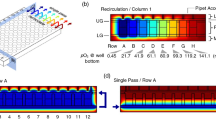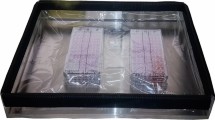Summary
The influence of oxygen on the growth and the in vitro chemosensitivity of human tumor cells was studied in the soft-agar assay. Tumor cells of pancreatic and ovarian origin prefer a reduced oxygen atmosphere for colony formation, whereas those of pulmonary origin grow better in 20% oxygen. Depending on the physiologic oxygen tension and the histologic origin of a particular cancer type, the in vitro chemosensitivity of many drugs obtained with the conventional culture system could be inadequately assessed.
The in vitro responses of tumor cells to combinations of drugs were measured by the regimen efficacy index (REI) method. The REI delineates the possible regimen enhancement or regimen default based on the in vitro chemosensitivity of the individual agents tested in the assay. In vitro regimen enhancement was observed only in ascites incubated in a reduced oxygen atmosphere with two-drug combinations. However, regardless of the oxygen gradients used, regimen default was seen in cancer cells of solid tumors treated with all combinations of drugs tested. This study suggests further investigation on the effects of oxygen in the soft-agar assay, and proposes the novel use of the REI method for evaluating the in vitro regimen chemosensitivity of human tumor cells.
Similar content being viewed by others
References
Alberts DS, Chen HSG, Soehnlen B, Salmon SE, Surwit EA, Young L, Moon TE (1980) In vitro clonogenic assay for predicting responses of ovarian cancer to chemotherapy. Lancet II:340–342
Bateman AE, Peckham MJ, Steel GG (1979) Assay of drug sensitivity for cells from human tumours: in vitro and in vivo tests on a xenografted tumour. Br J Cancer 40:81–88
Browman G, Goldberg J, Gottlib AJ, Preisler HD, Azarnia N, Priore RL, Brennan JK, Vogler WR, Winton EF, Miller KB, Grunwald H (1983) The clonogenic assay as a reproducible in vitro system to study predictive parameters of treatment outcome in acute nonlymphoblastic leukemia. Am J Hematol 15:227–235
Courtenay VD (1976) A soft agar colony assay for Lewis lung tumour and B16 melanoma taken directly from the mouse. Br J Cancer 34:39–45
Courtenay VD, Mills J (1978) An in vitro colony assay for human tumours grown in immune-suppressed mice and treated in vivo with cytotoxic agents. Br J Cancer 37:261–268
Fan D, Schneider C, Fan S, Blank H, Gillen L, Morgan LR (1984a) Effects of estrogen, tamoxifen and progesterone on a human breast cancer cell line in the soft-agar assay. In: Salmon SE, Trent JM (eds) Human tumor cloning. Grune & Stratton, New York, 477–486
Fan D, Fan S, Morgan LR (1984b) Sectional analysis of human tumor colony growth in the soft-agar assay: effects of oxygen. J Cancer Res Clin Oncol 108:181–185
Fan D, Morgan LR, Schneider C, Blank H, Fan S (1985) Cooperative evaluation of human tumor chemosensitivity in the soft-agar assay and its clinical correlations. J Cancer Res Clin Oncol 109:23–28
Greenberg BR, Salmon SE (1984) Human tumor clonogenic assay in patients with unknown primary carcinomas. J Clin Oncol 2:46–50
Gupta V, Krishan A (1982) Effect of oxygen concentration on the growth and drug sensitivity of human melanoma cells in softagar clonogenic assay. Cancer Res 42:1005–1007
Hager T (1982) Cancer drug sensitivity test has problems. J Am Med Assoc 248:3082–3084
Hamburger AW, Salmon SE (1977) Primary bioassay of human tumor stem cells. Science 197:461–463
Hug V, Thames H, Johnston D, Blumenschein G, Drewinko B, Spitzer G (1984) The true predictive value of the human tumor stem cell assay: Does a workable assay select for treatment responders? J Clin Oncol 2:42–45
Jiang TL, Liu RH, Salmon SE (1983) Antitumor activity of didemnin B in the human tumor stem cell assay. Cancer Chemother Pharmacol 11:1–4
Kornblith PL, Smith BH, Leonard LA (1981) Response of cultured human brain tumors to nitrosoureas: correlation with clinical data. Cancer 47:255–265
Ludwig CU, Durie BGM, Salmon SE, Moon TE (1983) Tumor growth stimulation in vitro by interferons. Eur J Cancer Clin Oncol 10:1625–1632
Meyskens FL, Alberts DS, Salmon SE (1983) Effect of 13-cis-retinoic acid and 4-hydroxyphenyl-all-trans-retinamide on human tumor colony formation in soft agar. Int J Cancer 32:295–299
Moon TE, Salmon SE, White CS, Chen HSG, Meyskens FL, Durie BGM, Alberts DS (1981) Quantitative association between in vitro human tumor stem cell assay and clinical response to cancer chemotherapy. Cancer Chemother Pharmacol 6:211–218
Oberley LW, Buettne GR (1979) Role of superoxide dismutase in cancer: a review. Cancer Res 39:1141–1149
Richter A, Sanford KK, Evans VJ (1972) Influence of oxygen and culture media on plating efficiency of some mammalian tissue cells. J Natl Cancer Inst 49:1705–1712
Salmon SE, Liu RM, Casazza AM (1981) Evaluation of new anthracycline analogs with the human tumor stem cell assay. Cancer Chemother Pharmacol 6:103–110
Selby P, Buick RN, Tannock I (1983) A critical appraisal of the “human tumor stem-cell assay”. N Engl J Med 308:129–134
Shoemaker RH, Curt GA, Carney DN (1983) Evidence for multidrug-resistant cells in human tumor cell populations. Cancer Treat Rep 67:883–888
Trent JM, Salmon SE (1980) Potential applications of a human tumor stem cell bioassay to the cytogenetic assessment of human cancer. Cancer Genet Cytogenet 1:291–296
Umbach G, Spitzer G, Drewinko B (1983) Clumpogenic v clonogenic assay. Lancet II:628
Von Hoff DD, Elson D (1980) Clinical results with cis-platinum in lung cancer. In: Prestayko AW, Crooke ST, Carter SK (eds) Cisplatinum.
Author information
Authors and Affiliations
Additional information
This work was supported in part by an American Cancer Society Grant # IN-150, and by Cancer Research Grants from the Elaa U. Pardee Foundation, Midland, Michigan, USA, and the Ladies Leukemia League of New Orleans, USA
Visiting scholar from the Chinese Academy of Agricultural Sciences, Shanghai Institute of Animal Parasitology, People's Republic of China
Rights and permissions
About this article
Cite this article
Fan, D., Morgan, L.R., Schneider, C. et al. Pharmacologic assessment of regimen chemosensitivity in the soft-agar assay: Effect of oxygen on human tumors. J Cancer Res Clin Oncol 110, 209–215 (1985). https://doi.org/10.1007/BF00399275
Received:
Accepted:
Issue Date:
DOI: https://doi.org/10.1007/BF00399275




